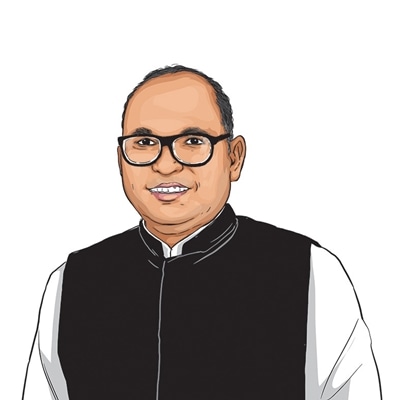Jan 5, 2025 18:42 IST
First published on: Jan 5, 2025 at 18:42 IST
In the last winter session of Parliament, the discussion on the Constitution turned into an ugly fight. Some Members of Parliament even ended up being physically injured when a scuffle broke out between the ruling and Opposition parties, and fingers were pointed at Rahul Gandhi, the leader of the Opposition. A BJP MP compared the incident with the 2001 attack on Parliament by Pakistan-based terrorist groups and said that the Opposition had entered Parliament like “urban Naxals”.
The attempt to brand Rahul Gandhi as an “urban Naxal” has been on for a while. In the lead-up to the last General Election, Rahul Gandhi’s speeches about the protection of the Constitution, social justice, caste census and redistribution of national wealth, was described as “Naxalite” agenda. Similar attempts were seen during the recent Assembly elections. Winning Maharashtra and Haryana was very important for the BJP for both political and economic reasons: One, to recover from the loss of seats in the General Election, and second, to get a hold over Mumbai and Gurgaon’s economies, as they have no control over Hyderabad, Bengaluru and Chennai where the new economy is thriving. Given Rahul Gandhi’s emergence as a people’s leader following his Yatras and the main face of the INDIA bloc, it was necessary for the BJP to diminish his appeal.
The BJP and its leadership have endeavored to bury Rahul Gandhi politically since his entry into active politics in 2004. Back then he was labeled as “Pappu”, an attempt to paint him as an immature leader. The BJP, along with its parent and sister organizations, successfully circulated this narrative among the masses — even the second-run leadership of the Congress party was influenced by it. His decision to go the Bharat Jodo Yatra (from Kanyakumari to Kashmir) and the Nyay Yatra (from Manipur to Mumbai) surprised many. It was a bold decision, involving not just walking across the country, but also responding to the problems raised by the people and facing the media. The way Rahul Gandhi connected with the people surprised both the BJP and Congress leaders. By the end of the first Yatra, he proved himself to be a strong mass leader, with the second Yatra cementing his appeal.
Why was the BJP troubled by this transformation? The BJP sees Congress as its main opposition, as well as a possible contender for power in Delhi, as it has an all-India character and network, unlike any regional party. The BJP also knows that Congress’s sole source of oxygen is the Gandhi family leadership. It believes that if the Gandhi family leadership can be displaced, it would be easy to demolish Congress, as it has no other leaders who can attract the masses at an all-India level. Not developing national-level leadership outside the Gandhi family has long been the biggest inherent weakness of Congress. The BJP could rise in terms of popularity and power only when the Gandhi family leadership was out of the main power seat. During UPA I and II, although the family controlled the party, it had projected an academician-administrator as prime minister, laying the ground for the BJP to rise to power.
So, keeping Congress at a low ebb is imperative for the BJP. As long as the BJP is in power, it can manage the regional parties as most of them have no ideological opposition to it. It is evident from the recent post-Assembly election scenario that most of the parties in the INDIA bloc have begun distancing themselves from Congress, holding it responsible for electoral debacles. Yet, the gains made by Congress in the General Election under Rahul Gandhi’s leadership is disturbing to the BJP. In particular, his social justice and wealth redistribution programs have the potential to destabilize the BJP, given the incredible response from the lower strata of society. The BJP is now using all its energy to discredit Rahul Gandhi’s leadership by weaving him into the “urban Naxal” narrative.
Is Congress in a position to protect Rahul Gandhi from the BJP’s attack? How many of its leaders are ideologically committed to his program of social justice and wealth redistribution? The answer to these questions is doubtful, unless the Congress party is completely revamped on the principle of social justice, from the Congress Working Committee to village-level committees. Most of its second-run leaders are conservatives and elitists, who don’t necessarily believe in what Rahul Gandhi is talking about. Indeed, while the Yatras had generated enthusiasm across the country, the second-level leadership measurably failed to capitalize on it and transform it into votes.
An interesting development of recent years is that many who had been critical of Congress in the past are now supporting it both directly and indirectly. But the Party doesn’t take them into confidence on a serious note. The old functioning style of the Party has to undergo complete surgery if it wants to reemerge into power.
Also troubling for Congress is that none of its allies have condemned the BJP’s attack on Rahul Gandhi’s leadership. Rather, like the BJP, they too are questioning his leadership after the recent Assembly elections.
Given this, the only option that may be left for Congress is to fight the BJP alone. This would be impossible in its present avatar, as politics in the country has become an ideological fight. The problem is that the Congress party has not been able to catch up with its leader, who has taken a bold, fresh position on various public issues. But Rahul Gandhi alone cannot turn the tide. He needs a new missionary who can transmit his ideas and ideology to the grassroots and inspire the people.
The writer teaches at the University of Hyderabad
Discover the benefits of our subscription!
Stay informed with access to our award-winning journalism.
Avoid misinformation with trusted, accurate reporting.
Make smarter decisions with insights that matter.
Choose your subscription package


